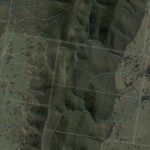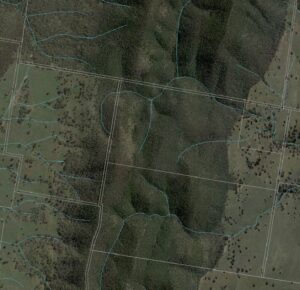Doherty Smith & Associates is now Compass Consulting Surveyors
Click here to see this blog and more on our new website compasscs.com.au
Lines on a map or legal access?
Crown Roads are found generally in rural parts of NSW, and were created in order to ensure that every portion of land had legal access to a road. In real terms, many of these crown roads, also known as “paper roads”, were not practical means of accessing land, traversing over steep and rough country. Although the crown roads provided legal access to all portions, this often did not translate to practical access on the ground.
Crown Roads were given a standard width of 100 links (20.115 metres), although in western areas of the state, road widths were often up to 300 links (60.35 metres) or more. The roads were generally left as a corridor between portions as they were created, or created over existing tracks in use where they went through a portion.
Today, land holdings tend to encompass multiple portions (lots), with crown roads running through and between lots. Many crown roads are used by the adjoining landowner as part of their property, which is made possible by either an enclosure permit or permissive occupancy arranged with the local Lands Office.
An enclosure permit allows the holder to enclose a crown road within their property by fencing, however the land must remain available for access if required. The crown road which is the subject of an enclosure permit can only be used for grazing stock or access purposes, with other uses not permitted, unless a land owner applies specifically for a permit. Under the Crown Lands Act 1989, the Minister may allow an enclosure permit holder to fence a road without gates and may authorise the cultivation of the land. Enclosure permits are more typically granted subject to the permit holder paying rent and erecting gates or providing some other means of access or both. Enclosure permits grated to a land owner are transferred with ownership of the land, meaning an existing enclosure permit attached to a property will remain with the property if it is sold and will be subject to the same conditions.
It is important to realise that the holder of an enclosure permit is considered the “owner” of the road in relation to dividing fences law. Thus, if a road divides two properties and is unfenced, an owner without the enclosure permit on the road can submit a fencing notice on the enclosure permit holder. Adjoining owners must share the cost of a dividing fence except in certain circumstances as outlined in our dividing fences law blog.
Enclosure permits on crown roads remain in place until the road is either: fenced from the adjoining properties; legally closed and then purchased by the adjoining owner/s, or; transferred to another authority such as the local Council.
The holder of an enclosure permit is charged an annual rental fee. NSW Department of Industry, Crown Lands, is encouraging enclosure permit holders to apply to close the roads they are currently playing rent on, and purchase the land within. For more information on closing crown roads, visit the NSW Crown Land Website or speak to an officer at your local Crown Lands Office.
In order to gain access to a portion of land, the land owner can use existing public roads, crown roads held by the crown or other authority, crown roads held under enclosure permit, or private means of access including creating an easement. Identifying the location of crown roads may require the services of a Registered Surveyor. A Registered Surveyor may also be able to find alternative means of access to the subject land with consideration of practical aspects. In the past, it has proven more cost effective to create a right of carriageway (easement) for access rather than surveying and possibly construction a viable access within the crown road.
Many crown roads are currently being closed by Crown Lands NSW at the request of adjoining land owners. This process is quite slow and involves the creation of a plan showing the roads as lots and creation of certificates of title for the land.
If you have any queries on crown roads, please contact Doherty Smith & Associates.
Eric Smith
Registered Surveyor





